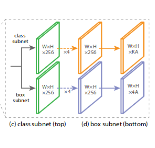Focal Loss和它背后的男人RetinaNet
加入极市专业CV交流群,与 10000+来自港科大、北大、清华、中科院、CMU、腾讯、百度 等名校名企视觉开发者互动交流!
同时提供每月大咖直播分享、真实项目需求对接、干货资讯汇总,行业技术交流。关注 极市平台 公众号 ,回复 加群,立刻申请入群~
说起Focal Loss,相信做CV的都不会陌生,当面临正负样本不平衡时可能第一个想到的就是用Focal Loss试试。但是怕是很多人会不知道这篇论文中所提出的one stage目标检测模型RetinaNet,这也难怪,就连论文里面也说了RetinaNet模型层面没有大的创新,模型效果主要靠Focal Loss。RetinaNet作为RCNN系中one stage检测模型的代表,我觉得依然有学习研究的价值,这不仅会让你加深对RCNN系模型的理解,而且有利于学习后面新的模型,毕竟后面很多模型都是借鉴了RetinaNet。这里将介绍Focal Loss和RetinaNet(比如FCOS和YOLACT),也会给出一些具体的代码实现。
Focal Loss
类别不平衡(class imbalance)是目标检测模型训练的一大难点(推荐这篇综述文章Imbalance Problems in Object Detection: A Review,其中最严重的是正负样本不平衡,因为一张图像的物体一般较少,而目前大部分的目标检测模型在FCN上每个位置密集抽样,无论是基于anchor的方法还是anchor free方法都如此。对于Faster R-CNN这种two stage模型,第一阶段的RPN可以过滤掉很大一部分负样本,最终第二阶段的检测模块只需要处理少量的候选框,而且检测模块还采用正负样本固定比例抽样(比如1:3)或者OHEM方法(online hard example mining)来进一步解决正负样本不平衡问题。对于one stage方法来说,detection部分要直接处理大量的候选位置,其中负样本要占据绝大部分,SSD的策略是采用hard mining,从大量的负样本中选出loss最大的topk的负样本以保证正负样本比例为1:3。其实RPN本质上也是one stage检测模型,RPN训练时所采取的策略也是抽样,从一张图像中抽取固定数量N(RPN采用的是256)的样本,正负样本分开来随机抽样N/2,如果正样本不足,那就用负样本填充,实现代码非常简单:
def subsample_labels(labels, num_samples, positive_fraction, bg_label):"""Return `num_samples` (or fewer, if not enough found)random samples from `labels` which is a mixture of positives & negatives.It will try to return as many positives as possible withoutexceeding `positive_fraction * num_samples`, and then try tofill the remaining slots with negatives.Args:labels (Tensor): (N, ) label vector with values:* -1: ignore* bg_label: background ("negative") class* otherwise: one or more foreground ("positive") classesnum_samples (int): The total number of labels with value >= 0 to return.Values that are not sampled will be filled with -1 (ignore).positive_fraction (float): The number of subsampled labels with values > 0is `min(num_positives, int(positive_fraction * num_samples))`. The numberof negatives sampled is `min(num_negatives, num_samples - num_positives_sampled)`.In order words, if there are not enough positives, the sample is filled withnegatives. If there are also not enough negatives, then as many elements aresampled as is possible.bg_label (int): label index of background ("negative") class.Returns:pos_idx, neg_idx (Tensor):1D vector of indices. The total length of both is `num_samples` or fewer."""positive = torch.nonzero((labels != -1) & (labels != bg_label), as_tuple=True)[0]negative = torch.nonzero(labels == bg_label, as_tuple=True)[0]num_pos = int(num_samples * positive_fraction)# protect against not enough positive examplesnum_pos = min(positive.numel(), num_pos)num_neg = num_samples - num_pos# protect against not enough negative examplesnum_neg = min(negative.numel(), num_neg)# randomly select positive and negative examplesperm1 = torch.randperm(positive.numel(), device=positive.device)[:num_pos]perm2 = torch.randperm(negative.numel(), device=negative.device)[:num_neg]pos_idx = positive[perm1]neg_idx = negative[perm2]return pos_idx, neg_idx
与抽样方法不同,Focal Loss从另外的视角来解决样本不平衡问题,那就是根据置信度动态调整交叉熵loss,当预测正确的置信度增加时,loss的权重系数会逐渐衰减至0,这样模型训练的loss更关注难例,而大量容易的例子其loss贡献很低。这里以二分类来介绍Focal Loss(FL),对二分类最常用的是cross entropy (CE)loss,定义如下:

其中 为真实标签,1表示为正例,-1表示为负例;而 为模型预测为正例的概率值。进一步可以定义:
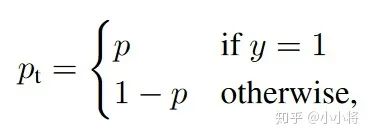
这样CE就可以简写为:
一般情形下,还可以为正例设置权重系数 ,负例权重系数为 ,此时的loss就变为:
如图1所示,蓝色的曲线表示CE,如果定义 的样本的容易例子,从曲线可以看到,这部分简单例子的loss值依然不低,而且这部分例子要占很大比例,加起来后将淹没难例的loss。这就是CE loss用于目标检测模型训练所存在的问题。
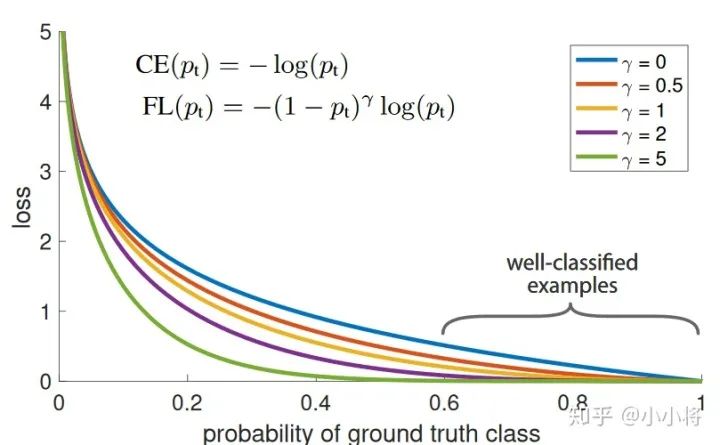
为了解决CE的问题,FL在CE基础上增加一个调节因子 ,FL定义如下:
图1给出了 时的FL曲线,可以看到当 很小时,此时样本被分类,调节因子值接近1,loss不受影响,而当 趋近于1时,调节因子接近0,这样已经能正确分类的简单样例loss大大降低。超参数 为0时,FL等价于CE,论文中发现取2时是最好的,此时若一个样本的 为0.9,其对应的CE loss是FL的100倍,可见FL相比CE可以大大降低简单例子的loss,使模型训练更关注于难例。如果加上类别权重系数,FL变为:
FL的实现也非常简单,这里给出Facebook的官方实现:
def sigmoid_focal_loss(inputs: torch.Tensor,targets: torch.Tensor,alpha: float = -1,gamma: float = 2,reduction: str = "none",) -> torch.Tensor:"""Loss used in RetinaNet for dense detection: https://arxiv.org/abs/1708.02002.Args:inputs: A float tensor of arbitrary shape.The predictions for each example.targets: A float tensor with the same shape as inputs. Stores the binaryclassification label for each element in inputs(0 for the negative class and 1 for the positive class).alpha: (optional) Weighting factor in range (0,1) to balancepositive vs negative examples. Default = -1 (no weighting).gamma: Exponent of the modulating factor (1 - p_t) tobalance easy vs hard examples.reduction: 'none' | 'mean' | 'sum''none': No reduction will be applied to the output.'mean': The output will be averaged.'sum': The output will be summed.Returns:Loss tensor with the reduction option applied."""p = torch.sigmoid(inputs)ce_loss = F.binary_cross_entropy_with_logits(inputs, targets, reduction="none")p_t = p * targets + (1 - p) * (1 - targets)loss = ce_loss * ((1 - p_t) ** gamma)if alpha >= 0:alpha_t = alpha * targets + (1 - alpha) * (1 - targets)loss = alpha_t * lossif reduction == "mean":loss = loss.mean()elif reduction == "sum":loss = loss.sum()return loss
RetinaNet
RetinaNet可以看成RPN的多分类升级版,和RPN一样,RetinaNet的backbone也是采用FPN,anchor机制也是类似的,毕竟都属于RCNN系列作品。RetinaNet的整体架构如图2所示,包括FPN backbone以及detection部分,detection部分包括分类分支和预测框分支。

Backbone
RetinaNet的backbone是基于ResNet的FPN,FPN在原始的CNN基础上增加自上而下的路径和横向连接(lateral connections),如图3d所示。图3a这种是用图像金字塔构建特征金字塔,非常低效;图3b是只取最后的特征;图3c是取CNN的不同层次的特征,SSD是这样的思路,但是FPN更进一步,增加一个自上而下的逻辑,通过横向连接融合不同层次特征。
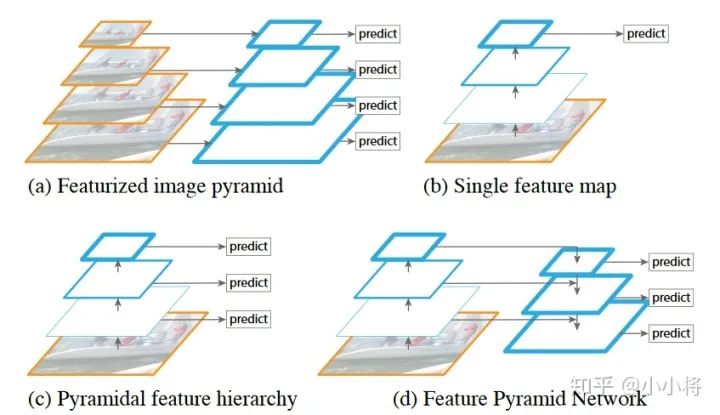
FPN的横向连接如图4所示,高层次特征进行一个2x的上采样(通过简单的最近邻插值实现),然后低层次特征用一个1x1卷积层降维,这样低层次特征和高层次特征维度一致(h, w, c均一致),直接相加。最后跟一个3x3卷积以消除上采样带来的不利影响。
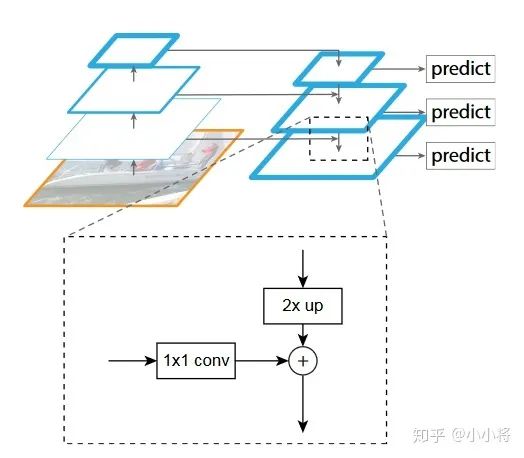
原始的ResNet共有4个stage,其得到的特征分别记为 ,相较于输入图像,它们的stride分别为 。FPN的构建从 开始,首先采用一个1x1卷积得到channel为C(FPN中取256,FPN中所有level的channel都是一样的)的新特征,然后就可以自上而下生成不同level的新特征,分别记为 ,与ResNet的特征是一一对应的,另外对 直接采用一个stride=2的下采样得到一个新特征 (基于stride=2的1x1 maxpooling实现),这样最后FPN实际上得到了5个不同level的特征,其stride分别为 ,特征维度均为C。Faster R-CNN是采用这样的FPN结构,但是RetinaNet却有稍许变动,第一点是只用ResNet的 ,这样通过FPN得到的特征是 ,相当于去掉了 , 的stride是4,特征很大,去掉它可以减少计算量,后面会讲到RetinaNet的anchor量和detection head都是比RPN更heavy的,这很有必要。另外新增两个特征 和 , 在 上加一个stride=2的3x3卷积得到, 是在 后面加ReLU和一个stride=2的3x3卷积得到。这样RetinaNet的backbone得到特征也是5个level,分别为 ,其stride分别为 。一点题外话就是FCOS的backbone也是取 ,也算是借鉴了RetinaNet。而YOLOV3的backbone是基于DarkNet-53的FPN,其特征共提取了3个层次,stride分别是 。
Anchor
RetinaNet的anchor和RPN是类似的,RPN的输入特征是 ,每个level的特征每个位置只放置一种scale的anchor,分别为 ,但是却设置3中长宽比 。RetinaNet的输入特征是 ,anchor的设置与RPN一样,但是每个位置增加3个不同的anchor大小 ,这样每个位置共有A=9个anchor,所有level中anchor size的最小值是32,最大值是813。在训练过程中,RetinaNet与RPN采用同样的anchor匹配策略,即一种基于IoU的双阈值策略:计算anchor与所有GT的IoU,取IoU最大值,若大于 ,则认为此anchor为正样本,且负责预测IoU最大的那个GT;若低于 ,则认为此anchor为负样本;若IoU值在 之间,则忽略不参与训练。这样每个GT可能与多个anchor匹配,但可能某个GT与所有anchor的IoU最大值小于 ,尽管不满足阈值条件,此时也应该保证这个GT被IoU值最大的anchor匹配。RPN中设定的两个阈值为 ,而RetinaNet设定的阈值为 。实现代码如下:
# compute IoUs between GT and anchors [M, N]match_quality_matrix = pairwise_iou(targets_per_image.gt_boxes, anchors_per_image)BELOW_LOW_THRESHOLD = -1BETWEEN_THRESHOLDS = -2low_threshold = 0.4high_threshold = 0.5# match_quality_matrix is M (gt) x N (predicted)# Max over gt elements (dim 0) to find best gt candidate for each predictionmatched_vals, matches = match_quality_matrix.max(dim=0)all_matches = matches.clone() # for allow_low_quality_matches# Assign candidate matches with low quality to negative (unassigned) valuesbelow_low_threshold = matched_vals < low_thresholdbetween_thresholds = (matched_vals >= low_threshold) & (matched_vals < high_threshold)matches[below_low_threshold] = BELOW_LOW_THRESHOLDmatches[between_thresholds] = BETWEEN_THRESHOLDS# For each gt, find the prediction with which it has highest qualityhighest_quality_foreach_gt, _ = match_quality_matrix.max(dim=1)# Find highest quality match available, even if it is low, including tiesgt_pred_pairs_of_highest_quality = torch.nonzero(match_quality_matrix == highest_quality_foreach_gt[:, None])pred_inds_to_update = gt_pred_pairs_of_highest_quality[:, 1]matches[pred_inds_to_update] = all_matches[pred_inds_to_update]
匹配的结果就是得到N维度(anchor数量)matches,其值表示与每个anchor匹配的GT index,计算loss时就可以找到对应的label和box,若值为-1,则是负样本,若值为-2,则是需要忽略。
另外,anchors和GT boxes之间的编解码方案与Faster R-CNN完全一样。
detection模块
检测模块主要包括分类分支和box回归分支,其中分类分支用来预测每个位置的各个anchor(数量为 )的类别概率(类别数为 ),而box回归分支用来预测每个位置各个anchor和GT之间的offset。分类分支包括4个3x3的卷积(ReLU激活函数,channel是256),最后是一个3x3的卷积,输出channel为 ,最后sigmoid激活就可以得到各个anchor预测每个类别的概率,对于RetinaNet来说,每个位置相当于 个二分类问题。box回归分支与分类分支类似,只不过最后输出channel是 ,这也表明RetinaNet的box回归是类别无关的。detection模块在FPN各个level的特征是参数共享的,这点和RPN类似,但是RetinaNet的detection模块是多分类的,而且更deeper。
模型初始化
对于backbone,当然采用的是在ImageNet上预训练的ResNet,其它新增的卷积层就普通初始化。一个额外要注意的点是分类分支最后的卷积层的偏值 初始化为:
这个 相当于是为模型训练开始时每个anchor预测为正例设置一个先验概率值,论文中采用的是0.01,只用这一条策略,基于ResNet50的RetinaNet在COCO上的AP值就能达到30.2。这是因为很多anchor是负例,设置先验值可以大大降低负样本在开始训练时的loss,这样训练更容易,RetinaNet很容易loss出现nan。另外这个策略也在另外一篇论文Is Sampling Heuristics Necessary in Training Deep Object Detectors?中被详细研究,经过少许的改进不需要sampling,也不需要focal loss也可以训练出较好的RetinaNet。
模型训练与预测
与Faster R-CNN一样,RetinaNet的box回归loss采用smooth L1,但是分类loss采用focal loss,论文中最优参数是 。分类loss是sum所有的focal loss,然后除以类别为正例的anchors总数。论文中FL也和OHEM或者SSD中的OHEM 1:3做了实验对比,发现采用FL的模型训练效果更好:
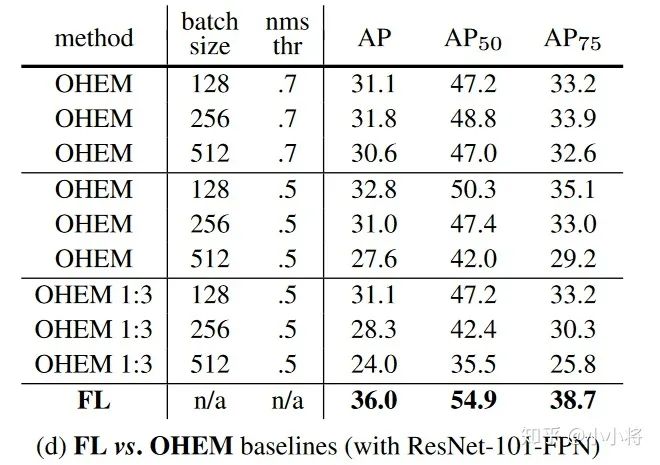
在inference阶段,对各个level的预测首先取top 1K的detections,然后用0.05的阈值过滤掉负类,此时得到的detections已经大大降低,此时再对detections的box进行解码而不是对模型预测所有detections解码可以提升推理速度。最后把level的detections结果concat在一起,通过IoU=0.5的NMS过滤重叠框就得到最终结果,代码如下:
boxes_all = [] scores_all = [] class_idxs_all = []
# Iterate over every feature level for box_cls_i, box_reg_i, anchors_i in zip(box_cls, box_delta, anchors): # (HxWxAxK,) box_cls_i = box_cls_i.flatten().sigmoid_()
# Keep top k top scoring indices only. num_topk = min(self.topk_candidates, box_reg_i.size(0)) # torch.sort is actually faster than .topk (at least on GPUs) predicted_prob, topk_idxs = box_cls_i.sort(descending=True) predicted_prob = predicted_prob[:num_topk] topk_idxs = topk_idxs[:num_topk]
# filter out the proposals with low confidence score keep_idxs = predicted_prob > self.score_threshold predicted_prob = predicted_prob[keep_idxs] topk_idxs = topk_idxs[keep_idxs]
anchor_idxs = topk_idxs // self.num_classes classes_idxs = topk_idxs % self.num_classes
box_reg_i = box_reg_i[anchor_idxs] anchors_i = anchors_i[anchor_idxs] # predict boxes predicted_boxes = self.box2box_transform.apply_deltas(box_reg_i, anchors_i.tensor)
boxes_all.append(predicted_boxes) scores_all.append(predicted_prob) class_idxs_all.append(classes_idxs)
boxes_all, scores_all, class_idxs_all = [ cat(x) for x in [boxes_all, scores_all, class_idxs_all] ] keep = batched_nms(boxes_all, scores_all, class_idxs_all, self.nms_threshold) keep = keep[: self.max_detections_per_image]
result = Instances(image_size) result.pred_boxes = Boxes(boxes_all[keep]) result.scores = scores_all[keep] result.pred_classes = class_idxs_all[keep]
这里要注意的是由于采用的 个二分类,某个位置的某个anchor可能最后会输出几个类别不同但是box一样的detections。
与其他模型的对比
相比SSD和YOLOV2,RetinaNet效果更优,效果对比如下图所示:
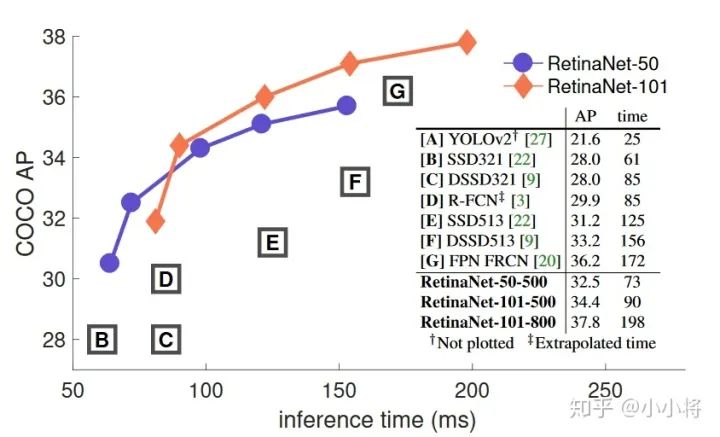
最后总结一下RetinaNet与其它同类模型的对比:
-
相比RPN,前面已经说过RetinaNet可以看成RPN的多分类升级版,backbone和FPN设置基本一样,只不过RPN采用简单的sampling方法训练,而RetinaNet采用FL; -
相比SSD,SSD也是利用多尺度特征,不过RetinaNet是FPN,SSD的anchor与Faster R-CNN类似,不过anchor的size和ratio有稍许差异,另外就是SSD是OHEM 1:3训练,而且采用softmax loss; -
相比YOLOV3,YOLOv3的backbone是基于DarkNet-53的类FPN结构,level只有3个,不过整体与RetinaNet的backbone接近;YOLOV3的anchor是基于k-means生成,而且匹配策略是基于center和IoU的策略,训练loss是普通的sigmoid。
对比之后,其实发现基于anchor的one stage检测模型差异并没有多大。
参考
1.Focal Loss for Dense Object Detection
2.facebookresearch/detectron2
3.Feature Pyramid Networks for Object Detection
4.Faster R-CNN: Towards Real-Time Object Detection with Region Proposal Networks
5.SSD: Single Shot MultiBox Detector
6.Training Region-based Object Detectors with Online Hard Example Mining
推荐阅读:
△长按添加极市小助手
△长按关注极市平台,获取最新CV干货
觉得有用麻烦给个在看啦~




